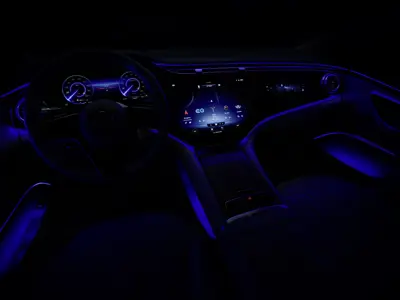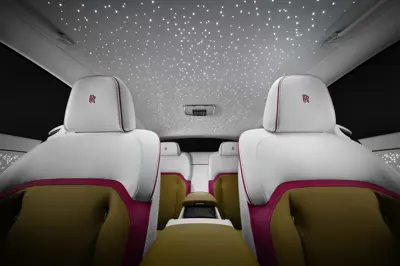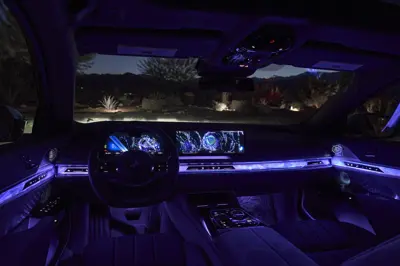Ambient Lighting
In recent years, automotive manufacturers have been exploring new ways to enhance the in-car experience, going beyond just performance and comfort. One such innovation that has gained popularity is interior ambient lighting, which uses strategically placed lights to create a visually appealing and relaxing atmosphere inside the vehicle.
Interior ambient lighting has evolved from a functional feature to a design element that elevates the aesthetics of the car's interior, creating a unique and personalized environment for the driver and passengers.
What is Interior Ambient Lighting?
Interior ambient lighting refers to the use of low-intensity lights placed in various locations throughout the interior of a vehicle to provide a soft, diffused glow. These lights are typically integrated into the car's interior, including the dashboard, door panels, footwells, center console, and even the headliner. They can emit a wide range of colors, intensities, and patterns, depending on the design and functionality of the system.
The purpose of interior ambient lighting is not only to provide illumination but also to enhance the overall ambiance and mood inside the car. It can create a cozy and inviting atmosphere, add a touch of luxury, or even evoke a sense of excitement. Many modern cars come equipped with ambient lighting as a standard or optional feature, and some manufacturers offer customization options that allow drivers to choose from a variety of colors and lighting effects to suit their preferences.
Advancements in Lighting Technology
Advancements in lighting technology have played a significant role in the evolution of interior ambient lighting in cars. Traditional incandescent bulbs have been largely replaced by more energy-efficient and versatile LED (light-emitting diode) lights. LED lights are small, durable, and can emit light in various colors without generating excessive heat, making them ideal for automotive applications.
LED lights used for interior ambient lighting can be controlled through sophisticated systems that allow for customization of color, intensity, and patterns. Some systems use RGB (red-green-blue) LEDs, which can produce millions of colors by mixing different intensities of these primary colors. Others may use single-color LEDs that are pre-set to emit a specific color. These lights can be controlled via a central control unit or through infotainment systems, allowing drivers and passengers to adjust the lighting according to their preferences and mood.
Design and Aesthetic Considerations
Design and aesthetics play a crucial role in interior ambient lighting, as it can significantly impact the overall look and feel of the car's interior. Automotive designers carefully consider the placement and design of ambient lighting to create a visually appealing and harmonious effect that complements the vehicle's overall design language.
One popular design approach is to use ambient lighting to highlight specific areas of the interior, such as the dashboard, door panels, or footwells. For example, soft blue lighting around the dashboard and center console can create a futuristic and high-tech ambiance, while warm orange or red lighting in the footwells can create a cozy and inviting atmosphere. Additionally, ambient lighting can be used to accentuate the lines, curves, and textures of the interior surfaces, creating a sense of depth and dimensionality.
Another design consideration is the choice of colors and lighting effects. Some manufacturers offer a wide range of colors, allowing drivers to customize the lighting to match their preferences or the mood they want to create. Popular colors include blue, red, green, white, and orange, among others. Lighting effects can vary from simple static illumination to dynamic effects that change in intensity, color, or pattern over time. For example, a soft pulsating blue light can create a calming effect, while a dynamic color-changing effect can add a sense of excitement and dynamism.
Functional Benefits of Interior Ambient Lighting
In addition to aesthetics, interior ambient lighting in cars also offers functional benefits that enhance the driving experience.
Improved Visibility: Ambient lighting can provide subtle illumination in key areas of the car's interior, such as the dashboard, center console, and door panels, which can improve visibility at night or in low-light conditions. It can help drivers locate controls, buttons, and switches more easily, reducing distractions and enhancing safety.
Reduced Eye Fatigue: Soft, diffused ambient lighting can help reduce eye fatigue during long drives, especially at night. Harsh, bright overhead lights can cause eye strain and discomfort, while ambient lighting creates a more soothing and relaxed environment, reducing eye strain and promoting a more comfortable driving experience.
Personalization: Interior ambient lighting allows drivers and passengers to customize the atmosphere inside the car according to their preferences and mood. It can be adjusted to different colors, intensities, and patterns, allowing for a personalized experience that reflects the driver's individual style and taste.
Mood Enhancement: Ambient lighting can have a significant impact on the mood and ambiance inside the car. Different colors and lighting effects can evoke various emotions, such as calmness, excitement, or warmth, enhancing the overall driving experience. For example, soft blue lighting can create a modern and serene ambiance, while warm orange lighting can create a cozy and inviting atmosphere.
Aesthetic Appeal: Interior ambient lighting adds a touch of luxury and sophistication to the car's interior. It can elevate the aesthetics of the cabin, creating a visually appealing and visually stimulating environment. Many car buyers consider ambient lighting as a premium feature that enhances the overall value and desirability of the vehicle.
Brand Differentiation: Interior ambient lighting can also serve as a unique branding element for car manufacturers. Customizable ambient lighting with distinct colors and lighting effects can help create a brand identity and differentiate a car model from competitors. It can also reinforce the brand's image and personality, adding to the overall brand experience.
Future Trends in Interior Ambient Lighting
As technology continues to advance, we can expect to see further innovations in interior ambient lighting in cars. Here are some future trends that we may see:
Smart and Connected Lighting: With the increasing connectivity of cars, we can expect to see more integration of ambient lighting with other in-car systems. For example, ambient lighting could be synchronized with the car's navigation system to change colors or intensities based on the driving conditions or route. It could also be integrated with the car's driver assistance systems, such as lane departure warning or collision detection, to provide visual cues or alerts. Synchronization with the sound system is already on the way.
Health and Wellness: Ambient lighting could also be used to promote health and wellness inside the car. For example, research has shown that certain colors of light can affect mood, sleep, and well-being. We may see the use of ambient lighting that promotes relaxation, reduces stress, or even adjusts to the driver's circadian rhythm for a more comfortable and healthy driving experience.
Augmented Reality (AR) Lighting: As augmented reality technology continues to develop, we may see the integration of ambient lighting with AR displays inside the car. This could create a more immersive and interactive experience, where ambient lighting could change dynamically to match the virtual environment displayed by the AR system, enhancing the overall driving experience.




